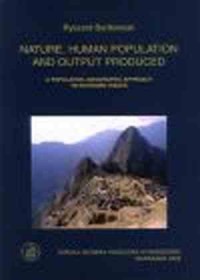Nature, Human population and output produced. A Population-Geographic Approach to Economic Issues
Ryszard Bartkowiak

| Dane szczegółowe: | |
| Wydawca: | Szkoła Główna Handlowa w Warszawie |
| Rok wyd.: | 2003 |
| Oprawa: | miękka |
| Ilość stron: | 106 s. |
| Wymiar: | 176x250 mm |
| EAN: | 9788373780613 |
| ISBN: | 83-7378-061-0 |
| Data: | 2001-01-09 |
Opis książki:
Książka "Nature, Human Population and Output Produced. A Population-Geographic Approach to Economic Issues" dr Ryszarda Bartkowiaka z Katedry Teorii Systemu Rynkowego, wydana przez Oficynę Wydawniczą SGH, traktuje o granicach wzrostu gospodarczego w skali światowej. Autor uwzględnia trzy zmienne: ludność, produkt oraz terytorium. Terytorium służy zarówno zamieszkiwaniu i wytwarzaniu produktu, jak i stanowi rezerwę przyrodniczej różnorodności. Terytorium można utożsamiać z dostępnymi zasobami przyrody, gdyż nawet rozstrzygnięcie problemu pozyskiwania energii nie odsunie faktu istnienia przestrzennych ograniczeń dla ekspansji gatunku ludzkiego (najbardziej widocznym z tych ograniczeń staje się woda). W oparciu o teorie ludnościowe Malthusa i Kremera autor analizuje dwa scenariusze rozwoju ludzkości: katastroficzny, który nieuchronnie wystąpi przy kontynuacji wzrostu gospodarczego według obecnego schematu, oraz ewolucyjny, gdy nastawienie do wzrostu w skali globalnej ulegnie zmianie, co jednocześnie oznaczałoby zmianę paradygmatu ekonomii. Man is part of nature. But what man regards reasonable in his or her action not necessarily must be reasonable from the viewpoint of nature. And very often it is not so since it is hard to imagine that nature - which has so far been tending towards developing diversity - could not suffer now due to the predominance of a single species. Thus it is high time to change our view on how a man-made economic system operates and to introduce into the set of main economic variables the forgotten Ricardian factor, i.e. territory, as only a handful of contemporary economists does. Not labor and capital, but territory is now emerging as the crucial factor determining and as well limiting the scope of human economic activity, and thus shaping the future of mankind. This is the issue the book deals with.
Książka "Nature, Human population and output produced. A Population-Geographic Approach to Economic Issues" - Ryszard Bartkowiak - oprawa miękka - Wydawnictwo Szkoła Główna Handlowa w Warszawie. Książka posiada 106 stron i została wydana w 2003 r.
Spis treści:
1.1. Origin of the human race
1.2. World population figures: one million BC to 2000
1.3. Population of world regions: AD 1 to 2000
Chapter 2. Typical forms of development of natural species
2.1. Growth rates of species
2.2. Catastrophic and evolutional changes of species
Chapter 3. Malthus’ principle of population
Chapter 4. Kremer’s population hypothesis
4.1. Origin: Adam Smith’s approach
4.2. Contribution by Leibenstein, Boserup and Simon
4.3. Derivation of Kremer’s population hypothesis
Chapter 5. Verification of the theories of world population development
5.1. Verification of Malthus’ principle of population
5.2. World population change to the year 2025
5.3. Verification of Kremer’s populations hypothesis
Chapter 6. Synthesis: world population development in the future
6.1. World population cohesion
6.2. Territory, population and output
6.3. Variants of world population development: a general approach
6.4. Catastrophic variant of world population development
6.5. Evolutionary variant of world population development
6.6. Juxtaposition of the variants: cyclical development of world population
Chapter 7. Projection and summary
7.1. Individual human territory
7.2. Future development of world population: a simplified approach
7.3. Future development of world population: an enlarged approach
7.4. Stages in the history of the human race
Chapter 8. Regional population development: historical tendencies
8.1. Delimitation of historic-geographical regions
8.2. Population phenomena in historic-geographical regions
Chapter 9. Regional population development: contemporary tendencies
9.1. Delimitation of economic-population regions
9.2. Population phenomena in economic-population regions
List of symbols
List of periods’ numbers for linear-regression functions
Literature
Books and articles
Encyclopedic and statistical publications

